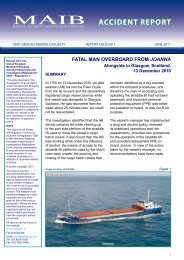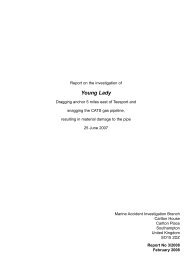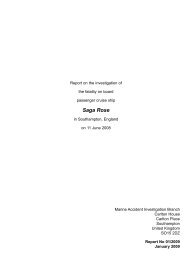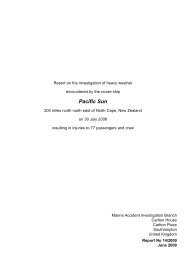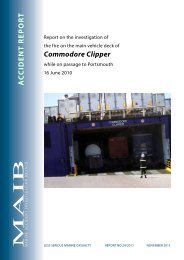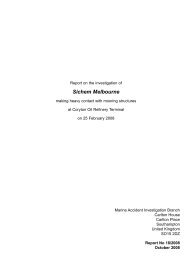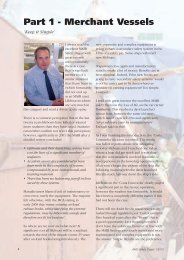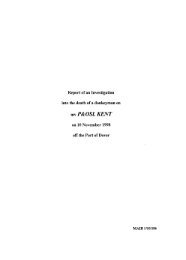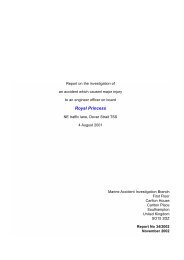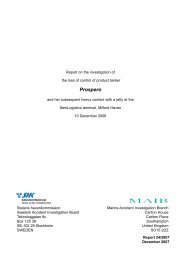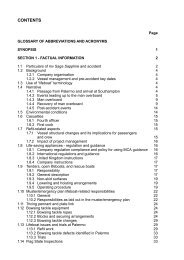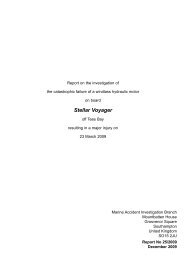Annex A Maersk checklist - Heavy Weather
Annex A Maersk checklist - Heavy Weather
Annex A Maersk checklist - Heavy Weather
Create successful ePaper yourself
Turn your PDF publications into a flip-book with our unique Google optimized e-Paper software.
<strong>Maersk</strong> <strong>checklist</strong> - <strong>Heavy</strong> <strong>Weather</strong><br />
<strong>Annex</strong> A
Checklist - <strong>Heavy</strong> <strong>Weather</strong><br />
A.P.Moller Group ID:416 - 18/09/2007 - 02 - 6 months<br />
Vessel: Mærsk Topper Date:<br />
A vessel specific heavy weather <strong>checklist</strong> shall be available onboard all vessels to facilitate an efficient "making ready for<br />
sea" check on departure from port, bound for an ocean passage, when expecting adverse weather between coastal ports, or<br />
when the weather detriorates while on route the inclusion of items below shall be considered and the shipboard management<br />
shall, thoroughly and well in advance, compose their own <strong>checklist</strong> with all appropriate check items<br />
Item<br />
<strong>Weather</strong> routing and forecasts scrutinised<br />
<strong>Heavy</strong> <strong>Weather</strong> maneuvering characteristics known and consulted<br />
Personnel instructed and familiar with available means for heavy weather response<br />
Loading condition - (e.g. GM, stress, tank shoshing, immersion of propeller, freeboard)<br />
Container stacking adjusted for ocean passage<br />
Container lashings rechecked/ tightened<br />
Hatchcover locking devices rechecked<br />
Anchors properly lashed and brakes engaged<br />
Dampers for ventilation on forecastle closed<br />
Ventilation for bowthruster closed<br />
Dampers for ventilation of cargo holds closed (reefer cargo holds exempted)<br />
Lashings on mono-rail crane rechecked<br />
Stores, equipment etc. stowed on deck secured<br />
Store room forward checked and additional lashings applied as necessary<br />
Paint locker checked and all paint secured<br />
Steering gear room checked and additional lashings applied as necessary<br />
Engine room checked and additional lashings applied as necessary<br />
Watertight doors closed<br />
Portable gangway properly secured<br />
Pilot ladders and hoists properly secured<br />
Chief Steward notified and provision room and gallery prepared for rough weather<br />
Furniture and appliances in Dining Saloon secured<br />
Furniture and appliances in Duty Mess secured<br />
Furniture in Officers Smoking Room secured<br />
Furniture in Crew's Dayroom secured<br />
Furniture in Conference Room secured<br />
Additional lashings on PC monitors, copy machines and printers<br />
Deck control room prepared for rough weather<br />
Bridge prepared for rough weather<br />
If rolling exceeding 30 degrees the engine room to be manned<br />
Crew instructed about any restrictions in work outside accommodation<br />
Master: Torben Wierdt Læbo<br />
(signature)<br />
Page 1 of 1
Injury or fatality following waves washing onboard vessels<br />
as recorded in MAIB database�1998 – 200�<br />
<strong>Annex</strong> B
<strong>Annex</strong> B<br />
MAIB accident database records of injuries and fatalities to crew working on deck in heavy weather when a wave washed inboard.<br />
(Accidents occurring on board merchant vessels of 500gt or more of UK flag or in UK waters)<br />
1998 – 2007<br />
No Ship Type Injuries Fatalities Remarks<br />
1 Tanker 2 0 Bilge alarm in Bow thruster compartment sounded. Chief officer and deck crew went<br />
forward to investigate. Ventilators and hatch tightened and crew returned to<br />
accommodation. Chief officer and bosun delayed due to closing the forecastle door. As<br />
they moved aft they were hit by a wave.<br />
2 Rig supply 2 0 During a lull in operations, two ratings were sent on deck to check spaces for damage.<br />
While on deck they were hit by a large wave and both sustained injuries. The master<br />
had used the pre-briefed whistle signal to warn of the approaching wave, and the two<br />
men had been trying to take cover when the wave hit.<br />
3 Dive support vessel 1 0 A well operations supervisor went onto the main deck for some fresh air and was struck<br />
by a large wave. He was not found for some time since he had not told anyone he was<br />
going on deck.<br />
4 Dredger 1 0 Ship making passage in rough weather, though ship’s motion was relatively easy. Two<br />
ABs sent on deck to close ventilation covers which were letting in water. On<br />
completion, the ABs were returning to the accommodation when a wave washed on<br />
board, knocking one of the men into the ship’s side rails.<br />
5 Ro-Ro cargo 1 0 Ship was hove to in heavy weather. Three ABs were sent on deck to inspect the<br />
forecastle, when a large wave washed on board.<br />
6 Container 1 0 Crewman stumbled as he crossed the deck avoiding water washing on board.<br />
7 Passenger 1 0 While entering a door from the forecastle, a crewman got his leg caught in the door<br />
when the door was struck by a wave.
8 Container 1 0 Chief officer carrying out routine rounds in rough weather, left the underdeck<br />
passageway to check outside, when he was hit by a wave which washed him along the<br />
deck.<br />
9 Tanker 2 0 Two crewmen injured while working on deck by a wave washing inboard.<br />
10 Container 1 0 A crewman was carrying out rounds of the reefer containers, when a wave broke over<br />
the bow. The water surged along the deck, knocking the man against the steelwork.<br />
11 General cargo 1 0 When weighing anchor, the chief officer was hit by a wave breaking over the<br />
forecastle.<br />
12 Container 0 1 Crew member was washed overboard from the pilot door opening in the hull. He was<br />
never recovered.<br />
13 Container 3 1 With the ship moving easily, four crewmen were working forward. A large sea broke<br />
over the bow, washing three of the men into the iron work on the deck.<br />
14 Passenger 1 0 Vessel operating in heavy seas, pitched heavily. Seas shipped on board burst open a<br />
weathertight door. The water rushing into the passageway knocked a crewman over,<br />
injuring him.<br />
15 Tanker 1 2 Tanker leaving port with men completing the securing of the forecastle after letting the<br />
tug go. Vessel pitched and shipped two large waves over the bow. This resulted in the<br />
deaths of two seamen and serious injury to a third.<br />
16 Safety standby vessel 1 0 After a stormy night, OOW noticed loose equipment on deck. Crew were sent to secure<br />
the same, and as they were coming off deck, the vessel shipped a sea, washing the<br />
seaman against a bulkhead.<br />
17 General cargo 2 0 Two crew members went on deck to secure equipment. Unexpected large wave washed<br />
on board, throwing both men against the accommodation bulkhead.
Amended SJA entitled “Movement on Deck in <strong>Heavy</strong> <strong>Weather</strong>”<br />
<strong>Annex</strong> C
MAERSK<br />
SJA Title Authorising Officer Assessor.<br />
Safe Job Analysis<br />
DECK - MOVEMENT ON DECK IN HEAVY WEATHER crew member I crew member 2<br />
Location(s): Creation Date:<br />
location 1 29/0112009<br />
Wa on eck ~<br />
Hazard Effect Consequence Probability Risk<br />
Wash overboard/being Involving a serious injury or fatality (C4) Possible, i.e. the event may have occurred<br />
submerged/drowning and represents a credible scenario (P4)<br />
Control Measures5 .. * -<br />
Description Responsible Person Consequence Probability Residual Risk<br />
Manoeuvring/reducing speed to Master Involving a serious injury or Possible, i.e. the event may<br />
ease the ship fatality (C4) have occurred and represents 16<br />
a credible scenario (P4)<br />
Use lifejackets/immersion suits Chief Officer Involving a serious injury or Possible, i.e. the event may<br />
fatality (C4) have occurred and represents 16<br />
a credible scenario (P4)<br />
Only use sheltered passage Chief Officer Involving a serious injury or Unlikely, less than average i.e.<br />
fatality (C4) easy to hypothesize an incident<br />
but unlikely (P3)<br />
Only daylight operations Master Involving a serious injury or Unlikely, less than average i.e.<br />
fatality (C4) easy to hypothesize an incident<br />
but unlikely (P3)<br />
Use lifelines Chief Officer Involving a serious injury or Highly unlikely, would require<br />
fatality (C4) multiple failures of systems and<br />
controls (P2)<br />
Prohibition to go on deck Master Negligible injury (first aid) (Cl) Highly unlikely, would require<br />
multiple failures of systems and<br />
controls (P2)<br />
ve~oi~ ~‘ , .<br />
Hazard Effect Consequence Probability Risk<br />
Being washed Involving a serious injury or fatality (C4) Possible, i.e. the event may have occurred<br />
against/submerged/drowning V and represents a credible scenario (P4)<br />
Con~l - asu~s - ‘~<br />
Description Responsible Person Consequence Probability ResIdual Risk<br />
Manoeuvring/reduce speed to Master Involving a serious injury or Possible, i.e. the event may<br />
ease the ship fatality (C4) have occurred and represents 16<br />
a credible scenario (P4)<br />
• Use of safety lines Chief Officer Involving a serious injury or Possible, i.e. the event may<br />
fatality (C4) have occurred and represents 16<br />
a credible scenario (P4)<br />
Use PPE Chief Officer Involving a serious injury or Unlikely, less than average i.e.<br />
fatality (C4) easy to hypothesize an incident 12<br />
but unlikely (P3)<br />
Only daylight operations Master Involving a serious injury or Highly unlikely, would require<br />
fatality (C4) multiple failures of systems and 8<br />
Prohibition to go on deck Master Negligible injury (first aid) (Cl) Highly unlikely, would require<br />
multiple failures of systems and 2<br />
SJA—97 page 1 of 2
Accelarations<br />
Slips, trips and falls<br />
Controj Meas res<br />
Hazard Effect<br />
Description Responsible Person<br />
Use safety lines Chief Officer<br />
Use PPE, proper footwear Chief Officer<br />
Watero dec<br />
Slips, trips and falls<br />
Control easures<br />
Hazard Effect<br />
Description<br />
Use of PPE/proper footware<br />
Movinglf lfln ects<br />
Being hit by<br />
Co troJ. ~ —<br />
Hazard Effect<br />
Description Responsible Person<br />
Sea secure eveyrhing/use Chief Officer<br />
heavy weather check list<br />
Prohibition to go out on deck Master<br />
Safe Job Anal sis uthoris tion<br />
This SJA has been authorised by crew member 1<br />
Consequence Probability Risk<br />
Injury leading to RWA or LTA (C3) Possible, i.e. the event may have occurred<br />
Consequence<br />
Injury leading to RWA or LTA (C3)<br />
Responsible Person<br />
Chief Officer<br />
1~ Signature: ~<br />
Consequence Probability<br />
Injury leading to RWA or LTA Possible, i.e. the event may<br />
(C3) have occurred and represents<br />
a credible scenario (P4)<br />
Injury leading to RWA or LTA Highly unlikely, would require<br />
(C3) multiple failures of systems and<br />
controls (P2)<br />
Consequence<br />
Injury leading to RWA or LTA<br />
(C3)<br />
Probability Risk<br />
Possible, i.e. the event may have occurred<br />
and represents a credible scenario (P4)<br />
-~ .,,~—.- . .. -‘<br />
Probability Residual Risk<br />
Highly unlikely, would require<br />
multiple failures of systems and<br />
controls P2<br />
Consequence Probability<br />
Involving a serious injury or fatality (C4) Unlikely, less than average i.e. easy to<br />
hypothesize an incident but unlikely (P3)<br />
Consequence<br />
Involving a serious injury or<br />
fatality (C4)<br />
SJA-’97 page 2 of2<br />
Negligible injury (first aid) (Cl)<br />
Probability<br />
Possible, i.e. the event may<br />
have occurred and represents<br />
a credible scenario (P4)<br />
Highly unlikely, would require<br />
multiple failures of systems and<br />
controls (P2L<br />
Residual Risk<br />
Risk<br />
Residual Risk<br />
~: Date:<br />
~———-——————~-..~..—j
<strong>Maersk</strong> Safety Flash 01/2009<br />
<strong>Annex</strong> �
SAFETY FLASH 01/2009<br />
Movement/Inspections on deck during heavy weather<br />
Event description:<br />
Issued by: SQHE Department, Copenhagen dated January 30th, 2009<br />
The following unfortunate incident occurred on board one of our vessels end of last year.<br />
Vessel departed from a port where a typhoon was approaching. <strong>Heavy</strong> weather <strong>checklist</strong> was<br />
run through and signed off. <strong>Weather</strong> situation outside was windforce 8/9 with a slightly rolling<br />
and pitching vessel.<br />
A few hours after departure, around 20.00 LT, due to a bilge alarm in the bosunstore, the C/O &<br />
C/E went up forward via the underdeck passageway to inspect the cause of the alarm.<br />
Vessel altered course to give a leeway and to steady the movement, and speed was also<br />
reduced. This gave a leeway to starboard side where the entrance from the under-deck<br />
passageway is situated.<br />
It appeared to the C/O’s and the C/E’s that<br />
there was a leakage from the forward store<br />
hatch. The C/O & C/E informed the bridge that<br />
the situation forward seemed favourable<br />
enough and that they would assess on deck<br />
whether the weather would allow further<br />
securing of the hatch once the vessel was<br />
steadied.<br />
Once the vessel was steadied for about ten minutes, both the C/E and C/O made the decision to<br />
go up to the maindeck entrance, which is situated some 15 metres aft of the gulfbreaker on the<br />
foc’sl, to check out the weather circumstances.<br />
As the weather was considered favourable from there, it was decided to go up forward to tighten<br />
the dogs of the hatch. After completing the task, both men intended to go back to the entrance<br />
of the lower passageway, when they noticed that the S/B anchor lashing (ocean lashing) had<br />
become slack as well.<br />
The C/E climbed on the pedestal where one end of the securing was situated, and the C/O<br />
remained on deck to assist.<br />
Busy with securing the ocean lashing, a green<br />
sea came over the foc’sl deck and both men<br />
were washed off their feet, with the C/E lying<br />
under the SB winch drum. Both the C/O and<br />
C/E were heavily wounded and requested<br />
assistance.<br />
Unfortunately after all due medical care, the C/E passed away the following night as a result of<br />
the internal wounds which he had sustained during the incident.
Recommended on board actions:<br />
• Review/create new and if necessary revise the SJA “Movement on Deck during <strong>Heavy</strong><br />
<strong>Weather</strong>” to include lessons learnt from incident.<br />
• Departure checks should be reviewed, especially when heading into rough weather.<br />
• Emphasise onboard the importance of a Risk Assessment prior to tasks involving<br />
hazards.<br />
• Assess whether it really is necessary go out on deck during bad weather<br />
• Avoid inspections on deck during dark hours<br />
• If circumstances make it necessary to go on deck, make sure that the vessel is<br />
heading in such a direction that ‘green water’ cannot be encountered.<br />
• If inspection is found necessary, determine reporting intervals/times/periods via<br />
handheld radio’s<br />
• A third man should be over viewing the inspection team from a safe point<br />
• Consider the use of the right PPE, also making use of lifelines.<br />
• The equipment on deck should be kept well maintained and in good working order so<br />
as to prevent water ingress in the foreship (forecastle, forepeak, hold no.1) following<br />
heavy weather damage to closing appliances and/or deck structures.<br />
• All members of the work party should take the opportunity to identify further hazards<br />
and controls.<br />
• If there is any change that may<br />
alter the hazards and controls,<br />
the work party must STOP work<br />
and the prevailing risks must be<br />
reviewed. This can then be<br />
reflected in the revisions to the<br />
relevant SJA.<br />
The exposed forecastle deck, of course is especially vulnerable, where:<br />
• All closing appliances for openings into the hull should be subject to regular<br />
inspection and maintenance, particularly when trading in waters where heavy<br />
weather may be expected.<br />
• Locking devices for access hatches and doors should be kept in good working order<br />
so that unintended opening, due to green seas, is greatly reduced.<br />
• Condition and clamping devices of air and sounding pipes should also be subject to<br />
regular follow-up by the ships crew, as internal corrosion and inadequate clamping<br />
may turn out to be critical.<br />
• Anchor lashings should be inspected for tightness each day, when safe to do so.<br />
Recommended shoreside actions:<br />
• Review the <strong>Heavy</strong> <strong>Weather</strong> Procedures as in the GSMS<br />
• Reintroduction of the Emergency Response Manual, taking this incident into account.<br />
• Review the need for additional medical training for sea staff on top of the STCW<br />
requirements.<br />
Please discuss this Safety Flash and attached investigation report at your next Safety Committee<br />
Meeting. This Safety Flash must be filed according to procedure ID: 260 and be posted on board<br />
the vessel for 6 months.



